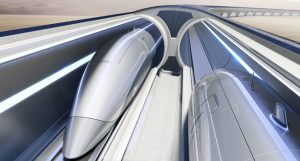Zaha Hadid Architects (ZHA) has signed an agreement with Hyperloop Italia to jointly design its next phase of works.
Using passive magnetic levitation technology powered entirely by renewables, Hyperloop propels passenger and cargo capsules through low-pressure tubes to minimize friction, requiring a fraction of the energy needed to power traditional modes of public transport.
Combining energy from renewable sources with regenerative braking systems makes Hyperloop’s infrastructure capable of producing more energy than it consumes, ZHA said in a press release. The climate-controlled passenger capsules travel in sealed tubes and remain unaffected by external conditions.

Image © Hyperloop Transportation Technologies
“We are looking forward to collaborating with Hyperloop Italia; marrying transformative architecture, engineering, and urban planning with the most efficient and sustainable transport network to significantly improve accessibility, connectivity, and well-being in our cities,” said Patrik Schumacher, ZHA principal.
“We share Hyperloop Italia’s multidisciplinary approach which combines innovations in design and operational technologies with advances in ecologically sound materials and construction practices; enabling us to deliver future-resilient projects that are spatially inventive, structurally efficient, and environmentally sustainable,” Schumacher said.
“We are certain Zaha Hadid Architects is the right partner to allow Hyperloop Italia to promote design excellence in architecture,” said Bibop Gresta, CEO of Hyperloop Italia. “Their decades of global experience in civic and transport infrastructure will be essential to ensure Hyperloop Italia’s transport hubs are intuitive to navigate, sustainable and fully integrated within their urban contexts.”





This sounds like a pneumatic tube that bank tellers use.
How do you handle emergency exiting?
Or handle emergency stops?
How do you get fresh air to the passengers?
If this is subterranean, how does this dig differ from the other pipelines recently banned form construction?
If this is above grade, how does this tube interact with other forms of traffic, nature, and the visual environment.
I would like to see more of the information on the safety, health & welfare of the public on this proposed human transit.